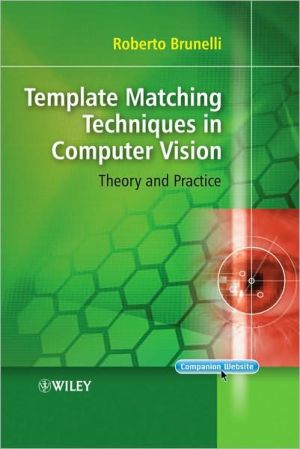

 |

|

Sold Out
Book Categories |
Preface ix
1 Introduction 1
1.1 Template Matching and Computer Vision 1
1.2 The Book 3
1.3 Bibliographical Remarks 7
References 8
2 The Imaging Process 9
2.1 Image Creation 9
2.1.1 Light 9
2.1.2 Gathering Light 13
2.1.3 Diffraction-limited Systems 20
2.1.4 Quantum Noise 21
2.2 Biological Eyes 23
2.2.1 The Human Eye 25
2.2.2 Alternative Designs 26
2.3 Digital Eyes 28
2.4 Digital Image Representations 33
2.4.1 The Sampling Theorem 33
2.4.2 Image Resampling 36
2.4.3 Log-polar Mapping 38
2.5 Bibliographical Remarks 40
References 41
3 Template Matching as Testing 43
3.1 Detection and Estimation 43
3.2 Hypothesis Testing 45
3.2.1 The Bayes Risk Criterion 47
3.2.2 The Neyman-Pearson Criterion 48
3.3 An Important Example 50
3.4 A Signal Processing Perspective: Matched Filters 54
3.5 Pattern Variability and the Normalized Correlation Coefficient 57
3.6 Estimation 60
3.6.1 Maximum Likelihood Estimation 61
3.6.2 Bayes Estimation 64
3.6.3 James-Stein Estimation 65
3.7 Bibliographical Remarks 70
References 71
4 Robust Similarity Estimators 73
4.1 Robustness Measures 73
4.2 M-estimators 81
4.3 L1 Similarity Measures 88
4.4 Robust Estimation of Covariance Matrices 92
4.5 Bibliographical Remarks 94
References 94
5 Ordinal Matching Measures 97
5.1 Ordinal Correlation Measures 97
5.1.1 Spearman Rank Correlation 100
5.1.2 Kendall Correlation 101
5.1.3 Bhat-Nayar Correlation 102
5.2 Non-parametric Local Transforms 104
5.2.1 The Census and Rank Transforms 104
5.2.2 Incremental Sign Correlation 107
5.3 Bibliographical Remarks 109
References 110
6 Matching Variable Patterns 113
6.1 MulticlassSynthetic Discriminant Functions 113
6.2 Advanced Synthetic Discriminant Functions 118
6.3 Non-orthogonal Image Expansion 121
6.4 Bibliographical Remarks 123
References 124
7 Matching Linear Structure: The Hough Transform 125
7.1 Getting Shapes: Edge Detection 125
7.2 The Radon Transform 129
7.3 The Hough Transform: Line and Circle Detection 132
7.4 The Generalized Hough Transform 141
7.5 Bibliographical Remarks 145
References 145
8 Low-dimensionality Representations and Matching 147
8.1 Principal Components 147
8.1.1 Probabilistic PCA 153
8.1.2 How Many Components? 155
8.2 A Nonlinear Approach: Kernel PCA 159
8.3 Independent Components 162
8.4 Linear Discriminant Analysis 167
8.4.1 Bayesian Dual Spaces 172
8.5 A Sample Application: Photographic-quality Facial Composites 173
8.6 Bibliographical Remarks 176
References 178
9 Deformable Templates 181
9.1 A Dynamic Perspective on the Hough Transform 181
9.2 Deformable Templates 184
9.3 Active Shape Models 188
9.4 Diffeomorphic Matching 192
9.5 Bibliographical Remarks 199
References 199
10 Computational Aspects of Template Matching 201
10.1 Speed 201
10.1.1 Early Jump-out 201
10.1.2 The Use of Sum Tables 203
10.1.3 Hierarchical Template Matching 204
10.1.4 Metric Inequalities 206
10.1.5 The FFT Advantage 208
10.1.6 PCA-based Speed-up 208
10.1.7 A Combined Approach 209
10.2 Precision 211
10.2.1 A Perturbative Approach 213
10.2.2 Phase Correlation 215
10.3 Bibliographical Remarks 216
References 218
11 Matching Point Sets: The Hausdorff Distance 221
11.1 Metric Pattern Spaces 221
11.2 Hausdorff Matching 224
11.3 Efficient Computation of the Hausdorff Distance 225
11.4 Partial Hausdorff Matching 228
11.5 Robustness Aspects 229
11.6 A Probabilistic Perspective 231
11.7 Invariant Moments 233
11.8 Bibliographical Remarks 234
References 235
12 Support Vector Machines and Regularization Networks 237
12.1 Learning and Regularization 237
12.2 RBF Networks 243
12.2.1 RBF Networks for Gender Recognition 244
12.3 Support Vector Machines 247
12.3.1 Improving Efficiency 254
12.3.2 Multiclass SVMs 256
12.3.3 Best Practice 258
12.4 Bibliographical Remarks 260
References 261
13 Feature Templates 263
13.1 Detecting Templates by Features 263
13.2 Parametric Feature Manifolds 269
13.3 Multiclass Pattern Rejection 272
13.4 Template Features 274
13.5 Bibliographical Remarks 278
References 279
14 Building a Multibiometric System 281
14.1 Systems 281
14.2 The Electronic Librarian 282
14.3 Score Integration 287
14.4 Rejection 290
14.5 Bibliographical Remarks 291
References 292
Appendices 293
A AnImAl: A Software Environment for Fast Prototyping 295
A.1 AnImAl: An Image Algebra 295
A.2 Image Representation and Processing Abstractions 297
A.3 The AnImAl Environment 300
A.4 Bibliographical Remarks 304
References 305
B Synthetic Oracles for Algorithm Development 307
B.1 Computer Graphics 307
B.2 Describing Reality: Flexible Rendering Languages 312
B.3 Bibliographical Remarks 316
References 317
C On Evaluation 319
C.1 A Note on Performance Evaluation 319
C.2 Training a Classifier 321
C.3 Analyzing the Performance of a Classifier 325
C.4 Evaluating a Technology 330
C.5 Bibliographical Remarks 333
References 333
Index 335
Login|Complaints|Blog|Games|Digital Media|Souls|Obituary|Contact Us|FAQ
CAN'T FIND WHAT YOU'RE LOOKING FOR? CLICK HERE!!! X
 You must be logged in to add to WishlistX
 This item is in your Wish ListX
 This item is in your CollectionTemplate Matching Techniques in Computer Vision: Theory and Practice
X
 This Item is in Your InventoryTemplate Matching Techniques in Computer Vision: Theory and Practice
X
 You must be logged in to review the productsX
 X
 X

Add Template Matching Techniques in Computer Vision: Theory and Practice, The detection and recognition of objects in images is a key research topic in the computer vision community. Within this area, face recognition and interpretation has attracted increasing attention owing to the possibility of unveiling human perception me, Template Matching Techniques in Computer Vision: Theory and Practice to the inventory that you are selling on WonderClubX
 X

Add Template Matching Techniques in Computer Vision: Theory and Practice, The detection and recognition of objects in images is a key research topic in the computer vision community. Within this area, face recognition and interpretation has attracted increasing attention owing to the possibility of unveiling human perception me, Template Matching Techniques in Computer Vision: Theory and Practice to your collection on WonderClub |